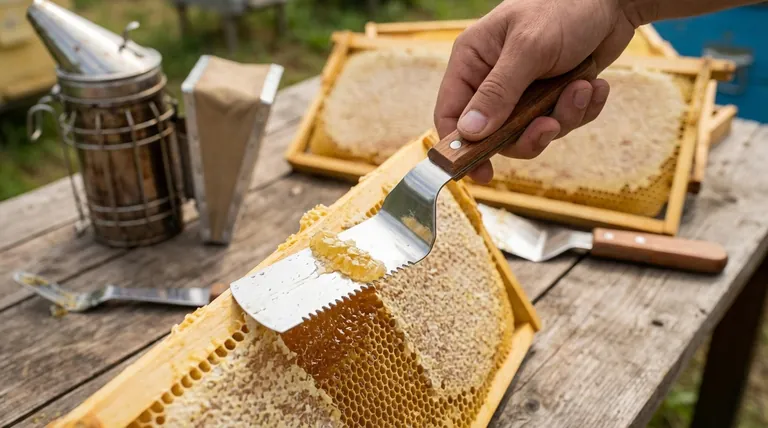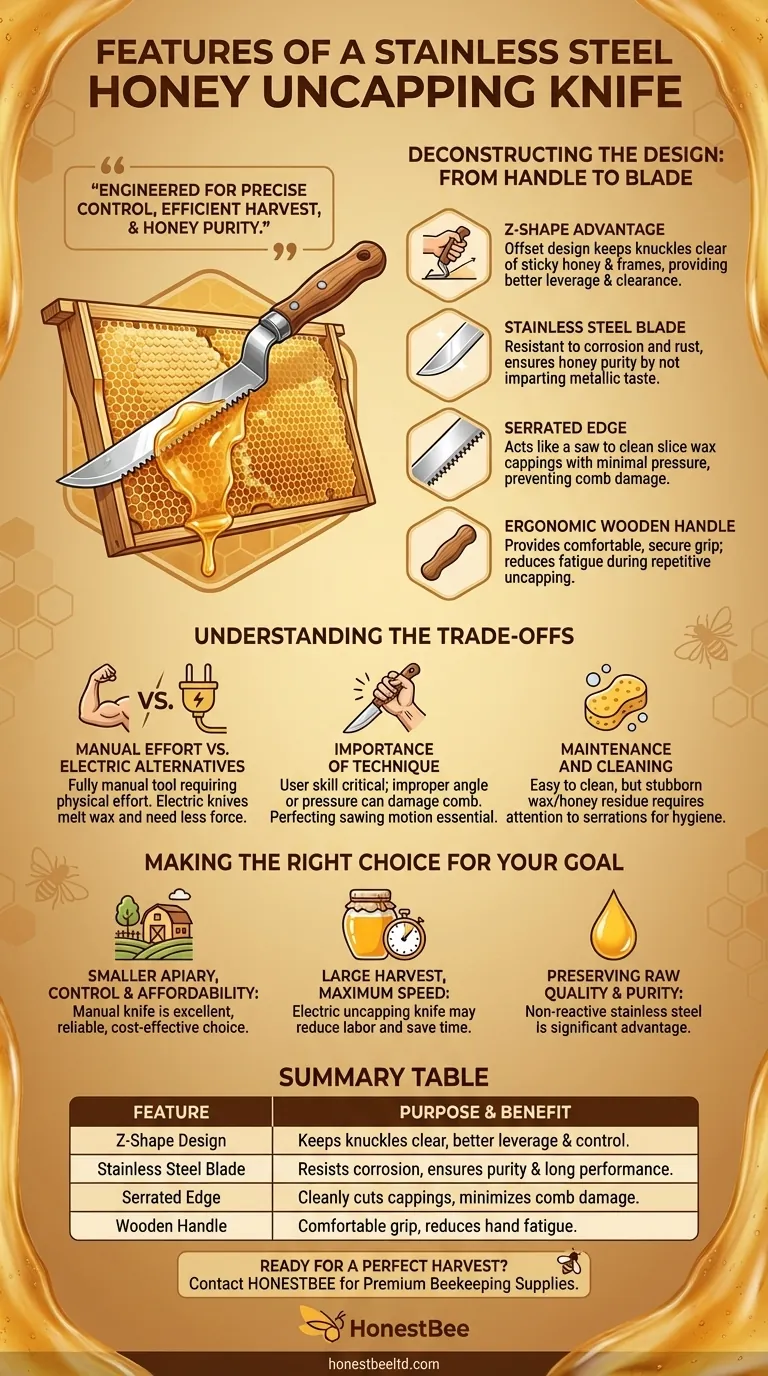At its core, a stainless steel honey uncapping knife is a specialized tool designed with a corrosion-resistant, serrated blade in a distinct Z-shape, complemented by a comfortable wooden handle. Its primary function is to cleanly slice the wax cappings off a honeycomb frame, preparing it for honey extraction.
The key takeaway is that every feature of this knife—from its offset shape to its serrated stainless steel blade—is engineered for a single purpose: to give beekeepers precise control for an efficient, clean harvest that preserves the absolute purity of the honey.

Deconstructing the Design: From Handle to Blade
The effectiveness of a stainless steel uncapping knife comes from the specific, intentional design of each of its components. Understanding their individual roles clarifies why this tool is a staple in beekeeping.
The Z-Shape Advantage
The most noticeable feature is the offset "Z" shape. This design deliberately places the handle above the plane of the blade.
This elevation keeps your knuckles out of the sticky honey and away from the frame as you slice downwards, providing better clearance and leverage.
The Stainless Steel Blade
The blade material is critical for both durability and food safety. Stainless steel is the material of choice because it is highly resistant to corrosion and rust.
Honey is slightly acidic, but this material ensures the knife will not degrade or impart any metallic taste. It maintains the honey's natural flavor, color, and aroma.
The Serrated Edge
Unlike a smooth blade, the serrated edge acts like a small saw. This design allows the knife to cut through the waxy cappings with minimal pressure.
This sawing action helps prevent the blade from tearing the wax or digging too deeply into the comb, resulting in a cleaner and more efficient uncapping process.
The Ergonomic Wooden Handle
The handle is typically made of wood to provide a comfortable and secure grip.
During the repetitive motion of uncapping multiple frames, a comfortable handle reduces hand fatigue and gives the beekeeper the precise control needed for a clean cut.
Understanding the Trade-offs
While an excellent tool, the manual stainless steel uncapping knife is one of several options, and it's important to understand its context.
Manual Effort vs. Electric Alternatives
This is a fully manual tool. It requires physical effort and a bit of technique, which can be tiring when processing a large number of frames.
For high-volume operations, beekeepers often turn to heated or electric uncapping knives, which melt through the wax and require less force from the user.
The Importance of Technique
The knife's design facilitates a clean cut, but user skill remains a key factor.
An improper angle or excessive pressure can still damage the comb, gouging out honey and making more cleanup work. Perfecting the shallow, sawing motion is essential for best results.
Maintenance and Cleaning
While stainless steel is easy to clean, wax and honey residue can be stubborn. The serrations, in particular, require attention to ensure all residue is removed after use to maintain hygiene for the next harvest.
Making the Right Choice for Your Goal
Selecting the right uncapping tool depends entirely on the scale of your operation and your personal priorities.
- If your primary focus is control and affordability for a smaller apiary: This manual knife is an excellent, reliable, and cost-effective choice that will last for years.
- If your primary focus is processing a large honey harvest with maximum speed: An electric uncapping knife may be a better investment to reduce manual labor and save time.
- If your primary focus is preserving the raw, unaltered quality of your honey: The non-reactive, easy-to-clean stainless steel blade is a significant advantage over other materials.
Ultimately, choosing the right tool is the first step toward a successful and rewarding honey harvest.
Summary Table:
| Feature | Purpose & Benefit |
|---|---|
| Z-Shape Design | Keeps knuckles clear of honey and frames, providing better leverage and control. |
| Stainless Steel Blade | Resists corrosion from honey's acidity, ensuring honey purity and long-lasting performance. |
| Serrated Edge | Cuts wax cappings cleanly with a sawing action, minimizing comb damage and effort. |
| Wooden Handle | Offers a comfortable, secure grip to reduce hand fatigue during repetitive use. |
Ready to equip your apiary with the right tools for a perfect harvest?
At HONESTBEE, we supply premium stainless steel uncapping knives and a full range of durable beekeeping supplies to commercial apiaries and distributors. Our wholesale-focused operations ensure you get reliable, high-performance equipment that protects the quality of your honey and boosts your efficiency.
Contact our expert team today to discuss your needs and discover how we can support your beekeeping success.
Visual Guide

Related Products
- HONESTBEE Advanced Ergonomic Stainless Steel Hive Tool for Beekeeping
- Heavy Duty Stainless Steel Honeycomb Cutter
- 10L Stainless Steel Electric Honey Press Machine
- Stainless Steel Dual Blade Uncapping Plane
- Professional Wide Blade Honey Scraper for Beekeeping and Honey Processing
People Also Ask
- Why do hive tools have a hole? Unlock the Secret to Efficient Beekeeping
- What are the basic tools for beekeeping? Essential Starter Kit for Safe & Successful Hive Management
- What are some common uses of a hive tool? Essential Multi-Purpose Tool for Every Beekeeper
- Why is it important to compare the progress of different hives? A Beekeeper's Key Diagnostic Tool
- What tools are used for cleaning frames? A Beekeeper's Simple 4-Tool Guide



















